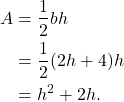Problem 195: An architect is designing the entryway of a restaurant. She wants to put a triangular window above the doorway. Due to energy restrictions, the window can only have an area of 120 square feet and the architect wants the base to be 4 feet more than twice the height. Find the base and height of the window.
Solution: Since the architect wants to build a “triangular” window, we are dealing with a triangle here. The area of a triangle is given by
(1) ![]()
where ![]() is the base and
is the base and ![]() is the height of the triangle. Moreover, the architect wants the base of the triangle to be 4 feet more than twice the height. Thus
is the height of the triangle. Moreover, the architect wants the base of the triangle to be 4 feet more than twice the height. Thus ![]() . Then
. Then
(2) 
Since the area needs to be 120 square feet, we have
(3) 
Since the height can’t be negative, the height of the triangle has to be 10 feet long. It follows that ![]() feet long.
feet long.
Hence, the triangle needs to have a base of 24 feet and height is 10 feet.

Leave a Reply